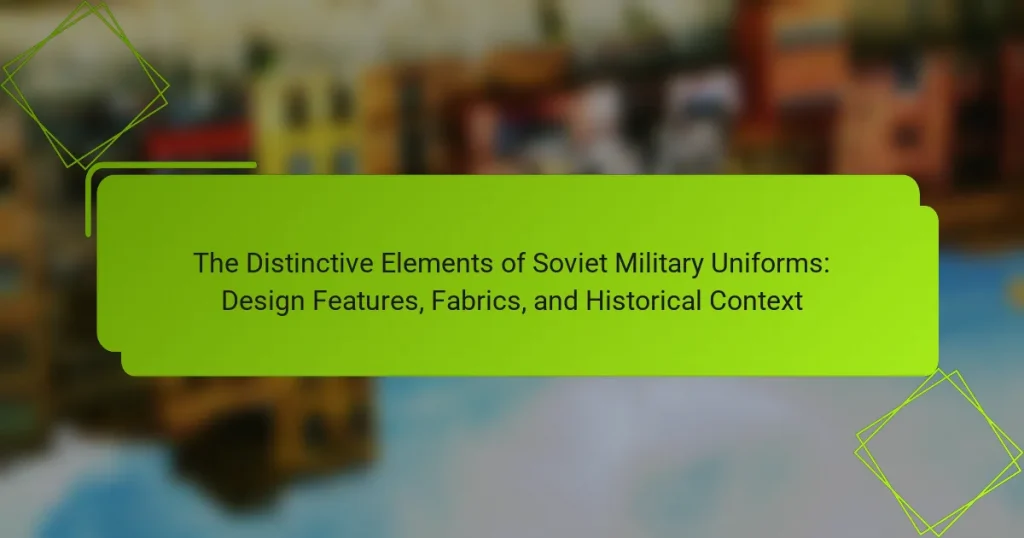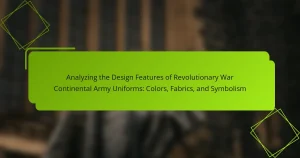Soviet military uniforms are defined by specific design elements, colors, and insignia that reflect their historical context. The primary color used in these uniforms was a shade of green, symbolizing military utility, while distinctive shoulder boards indicated rank and branch of service. Commonly made from wool and cotton for durability, these uniforms featured unique hats like the “pilotka” or “budenovka.” Insignia such as medals and badges were prominently displayed to signify achievements. The design of these uniforms evolved over time, mirroring shifts in military doctrine and aesthetics, and played a vital role in fostering identity and unity among Soviet troops.

What are the distinctive elements of Soviet military uniforms?
Soviet military uniforms are characterized by specific design elements, colors, and insignia. The primary color of these uniforms was often a shade of green, symbolizing military utility. They featured distinctive shoulder boards that indicated rank and branch of service. The use of wool and cotton fabrics was common, providing durability and comfort. Additionally, uniforms included a distinctive hat known as the “pilotka” or “budenovka,” which further identified soldiers. Insignia, such as medals and badges, were prominently displayed to denote achievements. The design evolved over different periods, reflecting changes in military doctrine and aesthetics. These uniforms played a crucial role in fostering a sense of identity and unity among Soviet troops.
How did the design features of Soviet military uniforms evolve over time?
Soviet military uniforms evolved significantly from the early 20th century to the dissolution of the Soviet Union. Initially, uniforms were characterized by traditional designs and heavy wool fabrics. The introduction of the Red Army in 1918 led to simpler and more functional designs, reflecting the need for practicality during wartime.
In the 1930s, the adoption of khaki colors and the use of lighter materials marked a shift towards modernity. This change aimed to enhance comfort and mobility for soldiers. During World War II, uniforms incorporated elements like shoulder boards and distinctive insignia to signify rank and unit affiliation.
Post-war designs in the 1950s and 1960s emphasized uniformity and discipline, featuring standardized cuts and colors across different branches of the military. The 1970s saw the introduction of camouflage patterns, reflecting a global trend in military attire.
By the late 1980s, uniforms began to reflect a more relaxed style, with the introduction of various fabrics and designs to accommodate different climates and operational needs. The evolution of Soviet military uniforms illustrates the balance between tradition, functionality, and the changing nature of warfare throughout the decades.
What were the key design principles behind Soviet military uniforms?
The key design principles behind Soviet military uniforms included functionality, uniformity, and symbolism. Functionality emphasized practicality for soldiers in various conditions. The uniforms were designed for ease of movement and durability. Uniformity ensured that all personnel appeared cohesive and disciplined. This was achieved through standardized designs and color schemes. Symbolism represented the ideals of the Soviet state. Emblems and insignia conveyed rank and affiliation. The use of specific colors, such as green and khaki, reflected military tradition. These principles were aimed at fostering a sense of identity and pride among troops.
How did historical events influence the design of these uniforms?
Historical events significantly influenced the design of Soviet military uniforms. The Russian Revolution of 1917 led to a shift in military aesthetics, prioritizing functionality and simplicity. During World War II, the need for practicality resulted in the use of durable fabrics and designs that allowed for ease of movement. The Cold War era introduced a more standardized look, reflecting the military’s role in promoting Soviet ideology. Additionally, the influence of various historical conflicts shaped specific uniform features, such as insignia and color schemes, to convey rank and unit affiliation. The evolution of these uniforms illustrates the direct impact of socio-political changes on military attire.
What types of fabrics were commonly used in Soviet military uniforms?
Soviet military uniforms were commonly made from wool, cotton, and linen fabrics. Wool was primarily used for its durability and warmth, especially in winter uniforms. Cotton provided comfort and breathability in summer attire. Linen was also utilized for its lightweight properties. These fabrics were chosen to meet the varying climatic conditions faced by soldiers. Historical records indicate that these materials were standard in the production of uniforms throughout the Soviet era. The combination of these fabrics ensured functionality and practicality for military personnel.
What are the characteristics of the fabrics used in these uniforms?
The fabrics used in Soviet military uniforms are characterized by durability, functionality, and weather resistance. These materials were specifically chosen to withstand harsh conditions. Wool was commonly used for its insulation properties. Cotton provided breathability and comfort during warmer months. Synthetic fibers were also incorporated for added strength and moisture-wicking capabilities. The blend of these fabrics ensured uniforms were practical for various climates. Historical records indicate that these fabric choices were essential for troop mobility and effectiveness.
How did fabric choices impact the functionality of the uniforms?
Fabric choices significantly impacted the functionality of Soviet military uniforms. The selection of durable materials enhanced protection against harsh weather conditions. Fabrics like wool provided insulation, while cotton offered breathability. These attributes ensured soldiers remained comfortable during various operational scenarios. Additionally, synthetic blends improved moisture-wicking properties. This feature helped maintain dryness during exertion. The choice of fabric also influenced uniform weight and mobility. Lightweight materials allowed for greater agility in the field. Overall, the fabric selections directly affected performance and effectiveness in military operations.
What role did historical context play in the development of Soviet military uniforms?
Historical context significantly influenced the development of Soviet military uniforms. The uniforms evolved through various political and social changes in Russia. The Bolshevik Revolution in 1917 marked a shift towards utilitarian designs. These designs aimed to reflect the new communist ideology and promote a sense of unity among soldiers. During World War II, practicality became paramount due to harsh conditions. The need for durable and functional materials led to innovations in fabric technology. Post-war, uniforms were designed to project power and national pride. The Cold War further emphasized distinctiveness in military attire to symbolize strength. Overall, historical events directly shaped the aesthetics and functionality of Soviet military uniforms.
How did the political climate affect uniform design and materials?
The political climate significantly influenced uniform design and materials in the Soviet military. During periods of heightened nationalism, uniforms featured bold colors and insignia to foster unity. The need for practicality during wartime led to the adoption of durable fabrics like wool and cotton. Political ideologies also shaped aesthetic choices, with designs reflecting socialist values. For instance, the introduction of unique insignia symbolized loyalty to the state. Additionally, resource availability during political turmoil impacted material selection, often prioritizing functionality over style. Historical events, such as World War II, necessitated rapid design adaptations to meet military needs.
What were the social implications of military uniforms in Soviet society?
Military uniforms in Soviet society symbolized authority and national pride. They were designed to create a sense of unity among soldiers. The uniforms distinguished military personnel from civilians. This distinction reinforced the military’s role in society. Uniforms also served as a visual representation of the state’s power. They projected an image of strength and discipline to the public. The design and colors often reflected Soviet ideals and patriotism. Additionally, military uniforms influenced social status and class perceptions within the population.
How do Soviet military uniforms compare to those of other nations?
Soviet military uniforms are characterized by their distinct designs, colors, and insignia, setting them apart from those of other nations. The Soviet military often utilized a drab green or grey color scheme, which was functional for camouflage. In contrast, many Western nations adopted more varied color palettes, including desert and urban patterns. Soviet uniforms typically featured a simpler, utilitarian design, emphasizing functionality over aesthetics. Other nations, especially in the West, often incorporated more elaborate designs and accessories.
The Soviet military also placed a strong emphasis on rank insignia and medals, which were prominently displayed. This contrasts with some nations that may use more subdued or hidden insignia. Additionally, Soviet uniforms were made from durable fabrics designed for harsh conditions, while other countries sometimes prioritized lighter materials for comfort. Historical context shows that Soviet uniforms evolved significantly during the Cold War, focusing on practicality, while other nations explored diverse styles influenced by fashion trends.
What are the similarities and differences in design elements?
Soviet military uniforms share similarities and differences in design elements. Similarities include utilitarian functionality and a focus on mass production. Both design styles emphasize practicality for soldiers in various environments. Differences arise in aesthetics and symbolism. Earlier designs featured simpler lines and muted colors, while later versions incorporated more elaborate insignia and patterns. Historical context influenced these variations, reflecting changes in military doctrine and national identity. For instance, the introduction of camouflage patterns in the 1960s marked a shift towards modern tactical needs.
How did international conflicts influence Soviet military uniform design?
International conflicts significantly influenced Soviet military uniform design by necessitating functional adaptations and aesthetic changes. The Russo-Japanese War of 1904-1905 prompted the introduction of more practical designs for soldiers. World War I led to the adoption of camouflage patterns to enhance concealment in various terrains. The Spanish Civil War saw the integration of more modern materials and ergonomic cuts for better mobility. World War II accelerated the development of uniforms that balanced durability and comfort, reflecting the harsh conditions faced by troops. Post-war conflicts, such as the Korean War, further influenced designs to accommodate new technologies and fabrics. Each conflict served as a catalyst for innovation, ensuring that Soviet military uniforms evolved in response to the demands of warfare. These adaptations were crucial for maintaining troop effectiveness and morale in diverse combat environments.
What are the practical considerations for preserving and displaying Soviet military uniforms today?
Preserving and displaying Soviet military uniforms today requires careful attention to materials and environmental factors. These uniforms are often made from wool, cotton, and synthetic fibers that can degrade over time. Proper storage involves using acid-free materials to prevent chemical reactions that damage fabrics. Displaying uniforms should be done in controlled environments, avoiding direct sunlight to prevent fading. Humidity levels should be kept low to deter mold growth. Regular inspections are essential to identify any signs of deterioration early. Additionally, using mannequins made of inert materials can help maintain the uniform’s shape without causing stress to the fabric. These practices are supported by conservation guidelines from institutions like the American Institute for Conservation.
What tips are there for maintaining the integrity of these historical uniforms?
To maintain the integrity of historical uniforms, proper care and storage are essential. Avoid exposing uniforms to direct sunlight, as UV rays can fade colors and damage fabrics. Store uniforms in a cool, dry place to prevent mold and mildew growth. Use acid-free tissue paper to support the structure of the uniform and prevent creasing. Regularly inspect the uniforms for signs of wear or damage. Clean uniforms gently, using appropriate methods for the specific fabric type. Consult conservation professionals for restoration needs. These practices help preserve the historical value and appearance of the uniforms.
How can collectors and historians effectively showcase Soviet military uniforms?
Collectors and historians can effectively showcase Soviet military uniforms through organized displays and informative context. They should use mannequins or shadow boxes to present the uniforms attractively. Labeling each piece with detailed descriptions enhances understanding of its historical significance. Incorporating photographs or documents from the era adds depth to the display. Utilizing appropriate lighting highlights the uniform’s colors and details. Collaborating with museums or historical societies can provide access to a wider audience. Engaging storytelling about the uniforms’ use in historical events captivates viewers. These methods have been successfully employed in various exhibitions, demonstrating their effectiveness.
The main entity of the article is Soviet military uniforms, which are defined by distinctive design elements, fabrics, and historical context. The article explores the evolution of these uniforms from their inception in the early 20th century through various historical events, highlighting key design principles such as functionality, uniformity, and symbolism. It examines the types of fabrics used, their impact on functionality, and how historical and political climates influenced uniform design and materials. Additionally, the article addresses the social implications of military uniforms in Soviet society and compares them with those of other nations, providing a comprehensive overview of their significance and preservation.




